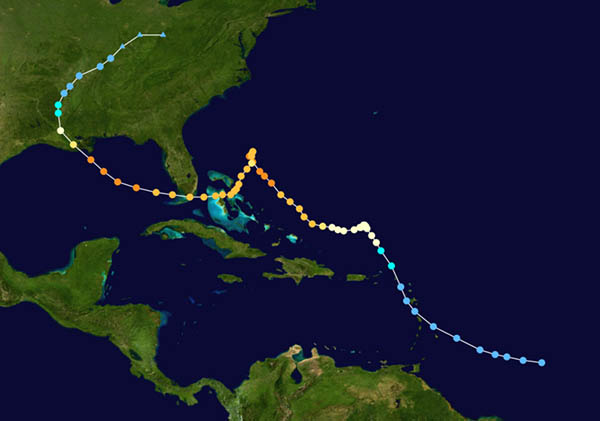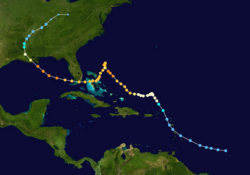Hurricane Betsy
In September 1965, Hurricane Betsy, one of the deadliest and costliest storms in US history, made landfall near New Orleans.

Courtesy of Wikimedia Commons
Hurricane Betsy Tracking. Unknown
For centuries, Louisiana’s coastal residents have been aware of the recurring dangers of tropical hurricanes. The first half of the 1960s saw destruction via Hurricanes Carla, Cindy, and Hilda, but the 1965 Atlantic hurricane season was one of the least active seasons on record, as only six cyclones grew to tropical-storm intensity. This fact, however, was no consolation for those exposed to the ravages of Hurricane Betsy when it made Louisiana landfall on September 9, 1965. Seventy-six people died, and the storm was the first hurricane to cause more than $1 billion in damages. The calamity led to the establishment of the US Army Corps of Engineers’ Hurricane Protection Program, which provided for New Orleans protection levees that infamously failed during Hurricane Katrina forty years later. Until 2005, Hurricane Betsy held sway as the benchmark natural disaster in the collective memory of generations of New Orleans-area residents.
The Path to Louisiana
An official US National Oceanic and Atmospheric Administration (NOAA) report is almost clinical in its description of the initial detection of the weather disturbance: “On August 27, 1965, at 10:30 AM EST a Navy hurricane reconnaissance aircraft discovered a tropical depression at latitude 13° north and longitude 54° west or about 350 miles east southeast of Barbados in the Windward Islands, West Indies. Maximum surface winds were about 38 knots [44 mph] and minimum sea level pressure was 1010 mb [29.82 inches], which soon lowered to 1006.5 mb [29.72 inches].” The rotation of the storm was soon confirmed with photographs from a TIROS X weather satellite. Later that day, as the storm tracked northwestward, it was named Betsy.
On August 28 the storm passed east of Puerto Rico; the next day it reached hurricane strength when highest winds of 80 miles per hour were recorded near the center. Hurricane advisories were issued promptly. In the next two days, the system slowed almost to a halt, made a tight clockwise loop, and was downgraded to a tropical storm when winds decreased to 65 miles per hour. On September 1, Betsy headed west and regained hurricane intensity. On September 2, peak winds were estimated at 125 to 150 miles per hour. During the days that followed, the fickle storm skirted the Bahamas, stopped again and performed another loop, and made an unusual movement southward before finally taking a bead on Miami, Florida. On the evening of September 7, Betsy struck south Florida with hurricane-force winds that lasted for twelve hours. Damage there was estimated at $100 million to $150 million, and four people were killed. As the storm continued northwest, it fed on the warm waters of the Gulf of Mexico, grew in intensity, and seemed to aim for the mouth of the Mississippi River.
Louisiana Landfall
On the morning of September 9, as the hurricane neared the Louisiana coast, the highest winds again were estimated at 150 miles per hour. Heavy rain, high tides, and tornadoes were forecast for the region. Offshore oil platforms were evacuated. By 6 p.m. the Grand Isle Coast Guard station had reported wind gusts of 160 miles per hour and sea level pressure of 28.00 inches — the lowest pressure ever recorded in Louisiana at that time. The huge eye of Hurricane Betsy passed thirty miles west of Burwood at the mouth of the Mississippi River at 9 p.m. and made landfall near Grand Isle at 11 p.m. The Saffir-Simpson hurricane scale was not yet in use, but it retroactively rated Betsy as a Category 4 storm. Winds at the New Orleans Weather Bureau office exceeded 125 miles per hour when the instruments failed due to loss of power. Continuing northward, the center of the storm passed over Houma and west of Baton Rouge, still maintaining winds of 100 miles per hour. Farther inland it quickly lost strength; by the time what was left of Betsy reached Memphis, Tennessee, on September 11, it could no longer be tracked as a tropical storm.
Destruction and Aftermath
New Orleans was swamped with a ten-foot storm surge that endured for days. Levees for the Mississippi River Gulf Outlet in the Lower Ninth Ward and on both sides of the Industrial Canal failed. More than 164,000 New Orleans homes were flooded. Many drowned in the Ninth Ward and adjacent St. Bernard Parish when water reached eave height, a situation similar to what occurred during Hurricane Katrina in 2005; after the water receded, some drowning victims were found in their attics, where they had retreated to try to escape the flooding. Almost sixteen feet of water inundated Grand Isle, destroying or damaging every building, and the fishing villages of Delacroix Island and Yscloskey were swept away in their entirety by flood waters. Sugarcane, cotton, and pecan crops were devastated over a wide region, and thousands of livestock drowned. Hundreds of ships, barges, and oilfield facilities were sunk or damaged. One barge laden with deadly chlorine gas sunk near Baton Rouge. Thirty miles of the Mississippi River channel were blocked by eleven shipwrecks. The total estimated storm damage was $1.42 billion (equal to $10.2 billion in 2015 dollars). Betsy was the first hurricane to cause destruction of more than $1 billion, and the majority was in Louisiana. Seventy-six deaths (reports vary slightly), most in Louisiana, were attributed to the storm. Because of the scale of the devastation caused by Hurricane Betsy, the name was retired from the tropical cyclone naming list.
On the afternoon of September 10, 1965, Louisiana Senator Russell Long called President Lyndon Johnson to ask for relief help and urged him to tour the devastated areas. Long emphasized the political values of such a visit for the president. Although Johnson’s relationship with the Louisiana delegation was barely amiable at the time, he arrived in New Orleans five hours after Long called, where he promised to cut through red tape and provide needed relief.
After surveying the damage, Gov. John McKeithen pledged that “nothing like this will ever happen again” and vowed that the state would put into place “procedures that will someday in the future make a repeat of this disaster impossible.” Though McKeithen had advocated a states’ rights platform in the wake of civil rights legislation, he actively sought federal assistance for the “tremendous amounts of money” needed to rebuild devastated sections of Louisiana. “Americanism in our state has … been reawakened and revitalized,” he said, “because … when we got in trouble … no suggestion was made, ‘Well, you people have been talking down there about states’ rights. You can take care of your own problems.’ ” He added that Louisianians were “greatly appreciative of the spontaneous and enthusiastic manner in which the federal government has come in here to help us.”
Emergency relief did arrive on many fronts: trailers were provided for the homeless and the US Navy assisted in recovering the toxic chlorine barge. Long-term assistance to prevent future tragedies of this kind was addressed with the Corps of Engineers’ new Hurricane Protection Program. New Orleans levees were redesigned and built to withstand a cyclone like Hurricane Betsy — powerful and fast-moving. Unfortunately, the requirements to resist such a storm are different from those needed to prevent destruction by an intense, slow-moving hurricane like Katrina.
